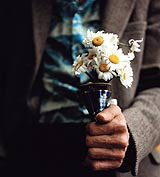Hidden agenda
Matt Baxter critiques Hide that Can, a photographical account of the forsaken lives of men living at the Arlington House refuge in London

Spilt booze, fag ends, Styrofoam cups, home-made tattoos, Xeroxed obituary notices, watery eyes, cut and bruises. Deirdre O’Callaghan’s remarkable photographs of Arlington House in Camden, its residents and their lives contain layers of detail and information that speak volumes about life inside the hostel. O’Callaghan’s book, Hide that Can is the result of a four-year project spent talking to and photographing the men of Arlington House, an imposing red brick building which, since 1905, has provided refuge for destitute, often alcoholic, mostly Irish expatriates who came to London in search of work and found themselves at odds with life in the capital.
The book is a collaboration between the photographer and designer Gerard Saint from Big Active. The pictures are a sad, poignant, often funny record of those four years. Described by U2’s Bono in the book’s introduction as ‘a true record of lives lived’, the photography is unflinching in its documentation of the effects of drink, neglect and isolation.
The shots afford their subjects a lot of dignity, avoiding showing the men in the worst light. The images are combined with first-hand quotes, reminiscences, jokes and confessions gathered from the residents, as well as song lyrics and quotes. The copy enables the men to have a voice and serves to flesh out their stories, providing an insight into their lives, hopes and fears.
The overriding impression is of men existing at the fringes of society with humour and resilience.
Saint compares his role on the project to that of a record producer: taking disparate elements (the photography, first-hand quotes, song lyrics) and making them work as a cohesive whole. The restrained typography, crisp grid structure and limited colour palette is characterful, while playing a supporting role to the photography. Clarendon Condensed as the main typeface works particularly well: suitably quirky but used with restraint.
There is wit at play in many of the spreads and type/image juxtapositions, as well as a strong sense of narrative pace: the visual transition from the imposing halls and corridors of Arlington to the beaches of Ireland is startling. To reinforce the importance of presenting the photography as simply as possible, the cover has no type on it: its straight-on shot of a green-hat-wearing, orange-bearded resident is a loose reference to the colours of the Irish flag. This clarity of presentation can be traced back to Saint’s notion that the book should be designed with the Arlington House residents in mind: it’s an inclusive approach to book design that suits the subject matter well.
With the publishing world not in the rudest of health, it’s great to see Trolley putting out this kind of personal, idiosyncratic book, which should find a wide audience. Its instinctive, enthusiastic approach to publishing should be applauded.
Matt Baxter is a senior designer at Blast.
Hide that Can, published by Trolley, is on sale at www.trolleynet.com, priced £24.95
-
Post a comment



